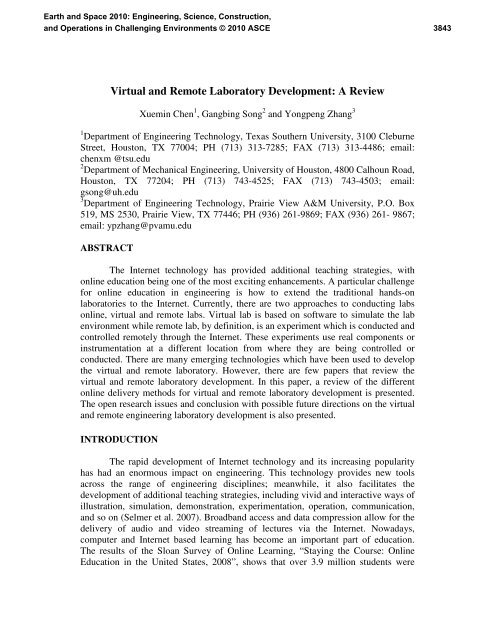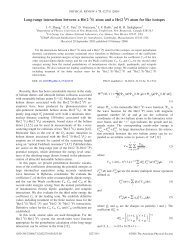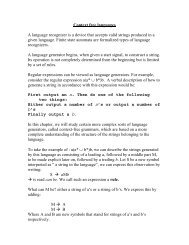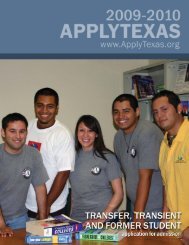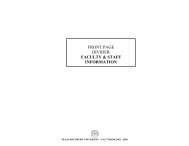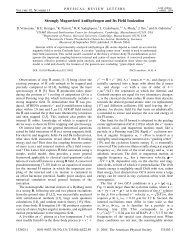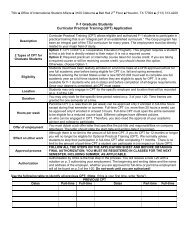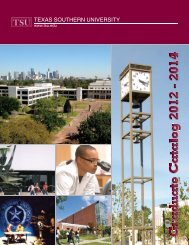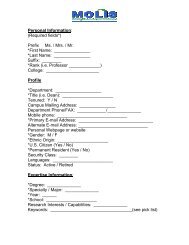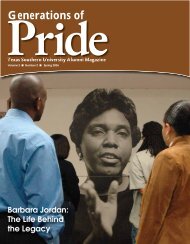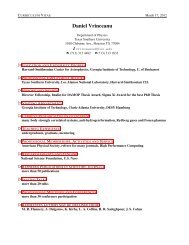Virtual and Remote Laboratory Development - Engineering ...
Virtual and Remote Laboratory Development - Engineering ...
Virtual and Remote Laboratory Development - Engineering ...
Create successful ePaper yourself
Turn your PDF publications into a flip-book with our unique Google optimized e-Paper software.
Earth <strong>and</strong> Space 2010: <strong>Engineering</strong>, Science, Construction,<br />
<strong>and</strong> Operations in Challenging Environments © 2010 ASCE<br />
3843<br />
<strong>Virtual</strong> <strong>and</strong> <strong>Remote</strong> <strong>Laboratory</strong> <strong>Development</strong>: A Review<br />
Xuemin Chen 1 , Gangbing Song 2 <strong>and</strong> Yongpeng Zhang 3<br />
1 Department of <strong>Engineering</strong> Technology, Texas Southern University, 3100 Cleburne<br />
Street, Houston, TX 77004; PH (713) 313-7285; FAX (713) 313-4486; email:<br />
chenxm @tsu.edu<br />
2 Department of Mechanical <strong>Engineering</strong>, University of Houston, 4800 Calhoun Road,<br />
Houston, TX 77204; PH (713) 743-4525; FAX (713) 743-4503; email:<br />
gsong@uh.edu<br />
3 Department of <strong>Engineering</strong> Technology, Prairie View A&M University, P.O. Box<br />
519, MS 2530, Prairie View, TX 77446; PH (936) 261-9869; FAX (936) 261- 9867;<br />
email: ypzhang@pvamu.edu<br />
ABSTRACT<br />
The Internet technology has provided additional teaching strategies, with<br />
online education being one of the most exciting enhancements. A particular challenge<br />
for online education in engineering is how to extend the traditional h<strong>and</strong>s-on<br />
laboratories to the Internet. Currently, there are two approaches to conducting labs<br />
online, virtual <strong>and</strong> remote labs. <strong>Virtual</strong> lab is based on software to simulate the lab<br />
environment while remote lab, by definition, is an experiment which is conducted <strong>and</strong><br />
controlled remotely through the Internet. These experiments use real components or<br />
instrumentation at a different location from where they are being controlled or<br />
conducted. There are many emerging technologies which have been used to develop<br />
the virtual <strong>and</strong> remote laboratory. However, there are few papers that review the<br />
virtual <strong>and</strong> remote laboratory development. In this paper, a review of the different<br />
online delivery methods for virtual <strong>and</strong> remote laboratory development is presented.<br />
The open research issues <strong>and</strong> conclusion with possible future directions on the virtual<br />
<strong>and</strong> remote engineering laboratory development is also presented.<br />
INTRODUCTION<br />
The rapid development of Internet technology <strong>and</strong> its increasing popularity<br />
has had an enormous impact on engineering. This technology provides new tools<br />
across the range of engineering disciplines; meanwhile, it also facilitates the<br />
development of additional teaching strategies, including vivid <strong>and</strong> interactive ways of<br />
illustration, simulation, demonstration, experimentation, operation, communication,<br />
<strong>and</strong> so on (Selmer et al. 2007). Broadb<strong>and</strong> access <strong>and</strong> data compression allow for the<br />
delivery of audio <strong>and</strong> video streaming of lectures via the Internet. Nowadays,<br />
computer <strong>and</strong> Internet based learning has become an important part of education.<br />
The results of the Sloan Survey of Online Learning, “Staying the Course: Online<br />
Education in the United States, 2008”, shows that over 3.9 million students were
Earth <strong>and</strong> Space 2010: <strong>Engineering</strong>, Science, Construction,<br />
<strong>and</strong> Operations in Challenging Environments © 2010 ASCE<br />
3844<br />
taking at least one online course during the 2007 Fall semester, a 12 percent increase<br />
over the number reported the previous year (Allen <strong>and</strong> Seaman 2008).<br />
A particular challenge for online education in engineering is how to extend<br />
the traditional h<strong>and</strong>s-on laboratory settings over the Internet. From the earliest days<br />
of engineering education, h<strong>and</strong>s-on laboratories have been an essential part of<br />
undergraduate engineering programs (Feisel <strong>and</strong> Rosa 2005); concepts taught through<br />
lectures are often complemented with laboratory experimentations. H<strong>and</strong>s-on<br />
education allows students to experience the backbone of engineering by conducting<br />
experiments, observing dynamic phenomena, testing hypotheses, learning from their<br />
mistakes, <strong>and</strong> reaching their own conclusions. With the rapid progress of the<br />
microprocessor <strong>and</strong> communication technologies, more <strong>and</strong> more instrumentations<br />
can be reconfigured <strong>and</strong> controlled remotely. These new functionalities have been<br />
making remote h<strong>and</strong>s-on training via Internet possible. New possibilities in the way<br />
lab exercises are performed include the simulation lab environment, the automated<br />
data acquisition <strong>and</strong> the remote control of instruments, all of which are online.<br />
Currently, there are two approaches to conducting labs online, virtual <strong>and</strong> remote<br />
labs.<br />
The virtual lab is based on software such as LabVIEW (short for <strong>Laboratory</strong><br />
<strong>Virtual</strong> Instrumentation <strong>Engineering</strong> Workbench), Matlab/Simulink, Java Applet,<br />
Flash or other software to simulate the lab environment. <strong>Virtual</strong> labs can be used for<br />
experiments that would normally require equipment that are too expensive, unsafe<br />
(e.g. nuclear reactor) or unavailable. <strong>Virtual</strong> labs also allow students to repeat an<br />
experiment multiple times, giving them the opportunity to see how changed<br />
parameters <strong>and</strong> settings affect the outcome. One of the very important features of the<br />
virtual lab is to let the students learn from failures without causing any real damages.<br />
Learning from failure is one of the nine objectives for the engineering education<br />
laboratory defined by ABET (Feisel <strong>and</strong> Peterson 2002). The “<strong>Virtual</strong> Reality<br />
<strong>Laboratory</strong> Accidents” project was developed at University of Illinois Chicago (Bell<br />
<strong>and</strong> Fogler 2001) by using virtual reality technologies such as <strong>Virtual</strong> Reality<br />
Modeling Language (VRML) <strong>and</strong> Java 3D. It is believed that these accidents will<br />
have more impact on users than written rules, even if it is not as much as real<br />
accidents.<br />
<strong>Remote</strong> lab, by definition, is an experiment which is conducted <strong>and</strong> controlled<br />
remotely through the Internet. The experiments use real components or<br />
instrumentation at a different location from where they are being controlled or<br />
conducted. For example, the University of Houston offers access to their remote<br />
laboratory for the Smart Materials <strong>and</strong> Structures <strong>Laboratory</strong> (Song et al. 2007). The<br />
logistics of tailoring a real laboratory, particularly when dealing with a large number<br />
of students, is often a big problem to universities; the requirements for space,<br />
instrumentation, <strong>and</strong> human support are high. <strong>Remote</strong> laboratories are more suited to<br />
h<strong>and</strong>le a large number of students, especially some small in size or limited in<br />
availability experiments, e.g. the nanotechnology experiments (Chang et al. 2002).<br />
A large amount of research on virtual <strong>and</strong> remote laboratory technologies has<br />
been recently reported, ranging from LabVIEW <strong>and</strong> Matlab/Simulink to Java applet,<br />
Flash, Ajax <strong>and</strong> other techniques. Our objective is to provide a deeper underst<strong>and</strong>ing<br />
of the current technology for online laboratory development, <strong>and</strong> to identify some
Earth <strong>and</strong> Space 2010: <strong>Engineering</strong>, Science, Construction,<br />
<strong>and</strong> Operations in Challenging Environments © 2010 ASCE<br />
3845<br />
open research issues on virtual <strong>and</strong> remote laboratory development. Ibrahim <strong>and</strong><br />
Morsi (2005) compared the different delivery methods for online engineering<br />
education; however, there are few papers to review the virtual <strong>and</strong> remote laboratory<br />
development.<br />
WEB-BASED EXPERIMENT FRAMEWORK<br />
The system block diagram of the <strong>Virtual</strong> <strong>and</strong> <strong>Remote</strong> <strong>Laboratory</strong> (VR-Lab) is<br />
shown in Figure 1. The functionality of the server is to work as the web publisher, the<br />
lab scheduler, the data <strong>and</strong> database manager. The workstations are used to execute<br />
the users’ requirements <strong>and</strong> control the lab devices such as the National Instruments<br />
Educational <strong>Laboratory</strong> <strong>Virtual</strong> Instrumentation Suite (NI ELVIS) to conduct the<br />
experiments. The camera will let the user to see the system response in real time. The<br />
users can use the client computers to do the experiments virtually <strong>and</strong> remotely.<br />
34 U<br />
4 U Router<br />
Lab Device<br />
Workstation<br />
Firewall<br />
8 U Server<br />
Lab Device<br />
Workstation<br />
3 U Storage<br />
Internet<br />
2 U UPS<br />
2 U<br />
NI ELVIS<br />
Clients<br />
Figure 1. Web-based experiment framework.<br />
VIRTUAL AND REMOTE LABORATORY DEVELOPMENT TOOLS<br />
Java<br />
Java was released in 1995 as a core component of Sun Microsystems' Java<br />
platform. It promised "Write Once, Run Anywhere" (WORA), providing no-cost runtime<br />
plug-in on popular platforms. Major web browsers soon incorporated the ability
Earth <strong>and</strong> Space 2010: <strong>Engineering</strong>, Science, Construction,<br />
<strong>and</strong> Operations in Challenging Environments © 2010 ASCE<br />
3846<br />
to run secure Java applets within web pages, <strong>and</strong> Java quickly became popular<br />
(Morelli <strong>and</strong> Walde 2006). Java has been involved in many virtual <strong>and</strong> remote<br />
laboratories since then. A Java Applet virtual lab was created by Chen et al. (2008).<br />
This virtual laboratory was for teaching the Resistor Color Code. It has two modes,<br />
the learn mode <strong>and</strong> the quiz mode, the default being the learn mode. In this mode, the<br />
user can use the combo box to select different combinations of the color b<strong>and</strong>s. The<br />
resistor value is then calculated by Java Applet. When the user picks the quiz mode,<br />
the Java Applet r<strong>and</strong>omly generates a combination of color b<strong>and</strong>s, after which the<br />
user inputs the resistor value into the textbox. A SUBMIT button is built for users<br />
submitting the answer for checking. Röhrig <strong>and</strong> Jochheim (2000) presented a<br />
framework using Java applets in the MySQL database for remote experiments at the<br />
University of Hagen, Germany. The developers developed a platform for setting up<br />
the remote experiments. A similar Internet based control engineering laboratory was<br />
later developed by Wu et al. (2006) that used Java applets to control a servo motor,<br />
inverted pendulum, coupled tank <strong>and</strong> fan-plate systems for the Zhejiang University,<br />
China. The control algorithms are implemented on PC-based or embedded<br />
microcontroller-based control servers. However, the developer developed the remote<br />
laboratory for some experiments but did not develop a st<strong>and</strong>ard framework so that<br />
others can use that framework <strong>and</strong> develop other experiments from different<br />
disciplines. Also, to run the remote experiments, the users had to install Java Runtime<br />
Environment (JRE). And the client does not communicate strictly by web based<br />
protocols <strong>and</strong> ports. Firewall transparency is, therefore, not possible.<br />
Flash<br />
A big advantage of Flash is that there is practically no browser compatibility<br />
issue. Since Flash files are only viewable with a plug-in, Flash will work the same<br />
when the user is on Firefox or Safari or IE, on Mac or PC. Flash has found a lot of<br />
applications in virtual laboratory design. A virtual microscopy was developed with<br />
Flash at the University of Delaware (Barrett et al. 2009). However, few people report<br />
using Flash for remote laboratory design. One of the Flash based remote laboratories<br />
was developed at the HAMK University of Applied Sciences, Finl<strong>and</strong> (Goffart 2007).<br />
A Flash interface was developed for the Programmable Logic Controller (PLC)<br />
control <strong>and</strong> real time PLC data display.<br />
VPN<br />
The work by Eslami et al. (2008), an online operation of a remotely controlled<br />
PLC unit is presented. Software including <strong>Remote</strong> Desktop <strong>and</strong> <strong>Virtual</strong> Private<br />
Network (VPN) has to be installed in the client computer.<br />
XML<br />
XML st<strong>and</strong>s for EXtensible Markup Language (Bray et al. 2008). It is a<br />
markup language much like HyperText Markup Language (HTML). However, XML<br />
is not a replacement for HTML; XML was designed to transport <strong>and</strong> store data, with<br />
the focus on the type of data. HTML was designed to display data, with focus on how<br />
the data looks.
Earth <strong>and</strong> Space 2010: <strong>Engineering</strong>, Science, Construction,<br />
<strong>and</strong> Operations in Challenging Environments © 2010 ASCE<br />
3847<br />
A XML-based remote control lab <strong>and</strong> electronic laboratory were reported by<br />
Pastor et al. (2005) <strong>and</strong> Bagnasco et al. (2005), respectively. Both of the works used<br />
XML to write the experiment configuration file; a Java enabled web browser was<br />
required to operate the experiments. The XML-based approach allows educators to<br />
create new Internet-based labs using legacy code (Pastor et al. 2005).<br />
Matlab/Simulink<br />
Matlab <strong>and</strong> Simulink are common tools in engineering <strong>and</strong> technology<br />
degrees in most universities. The Matlab environment, the Simulink toolbox <strong>and</strong> the<br />
Real-Time Workshop toolbox enable educators <strong>and</strong> students to focus on system<br />
design, implementation, <strong>and</strong> evaluation rather than on time-consuming, low-level<br />
programming. In Schmid (2001), a virtual laboratory which uses Matlab/Simulink for<br />
simulations using virtual reality is presented. In Casini et al. (2001), an Automatic<br />
Control Telelab (ACT) using Matlab/Simulink <strong>and</strong> Java servlet (interface) was<br />
developed. In Sánchez et al. (2004), a Matlab/Java based remote control system<br />
experiment for an inverted pendulum is presented. In their approach, they were using<br />
Matlab software with WinCom from Quanser as an interface.<br />
LabVIEW<br />
National Instruments’ (NI) LabVIEW is popularly deployed software for<br />
academic <strong>and</strong> industrial application. It is easy to control a real time process with NI’s<br />
graphic interface, hardware <strong>and</strong> drivers. DataSocket, an Internet programming<br />
technology included in the LabVIEW package, simplifies real time data exchange<br />
among computers connected through network (Edwards 1999; Edwards 2000).<br />
DataSocket is designed specifically for sharing, subscribing, <strong>and</strong> publishing real time<br />
data to multiple clients where a Uniform Resource Locator (URL) is used by the<br />
users to connect to a data source location in the DataSocket server. It provides the<br />
capability of the remote laboratory system to be accessed by multiple clients to do<br />
different experiments simultaneously.<br />
In Chang et al. (2002), Yang et al. (2005), Cotfas et al. (2006), just to name a<br />
few, LabVIEW <strong>and</strong> DataSocket based remote laboratories are developed. To bring<br />
the expensive <strong>and</strong> availability limited nanotechnology experiments into class, a<br />
nanopositioner control experiment for a senior undergraduate class is reported in<br />
Chang et al. (2002). Even with the graphic programming language, DataSocket,<br />
Internet Toolkit <strong>and</strong> other techniques provided by NI, the developers still need to take<br />
a lot of efforts to develop a remote laboratory. To simplify this procedure, a software<br />
prototype named <strong>Remote</strong> Lab Generator (RLGen) was proposed by Hasnim <strong>and</strong><br />
Abdullah (2007). Based on the experiment design <strong>and</strong> the HTML documents for the<br />
experiment, RLGen will auto-generate the student’s website where the student will<br />
then take the experiment through Internet. However, the RLGen did not solve the<br />
known compatibility issues of the ActiveX that is used for measurement <strong>and</strong> control<br />
purposes with the NI LabVIEW.<br />
One of the well developed remote labs is the Massachusetts Institute of<br />
Technology (MIT) iLab (Harward et al. 2008). iLab relies on a three-tier Web<br />
architecture including client applications, service broker <strong>and</strong> lab servers (Harward et<br />
al. 2008). However, some of the iLab control interfaces are based on LabVIEW <strong>and</strong>
Earth <strong>and</strong> Space 2010: <strong>Engineering</strong>, Science, Construction,<br />
<strong>and</strong> Operations in Challenging Environments © 2010 ASCE<br />
3848<br />
the user interface is based on ASP <strong>and</strong> ASP.NET web pages for web publishing.<br />
LabVIEW generally leads to version compatibility problems when updated <strong>and</strong> both<br />
ASP <strong>and</strong> ASP.NET pages are proprietary <strong>and</strong> only compatible with Microsoft<br />
Windows servers. The adaptability to other operating systems (Linux <strong>and</strong> Mac) <strong>and</strong><br />
web browser is still not guaranteed.<br />
Web 2.0<br />
The term “Web 2.0” first became notable after the O'Reilly Media Web 2.0<br />
conference in 2004 (O’Reilly 2005). Web 2.0 is not any updated technical<br />
specification as one might think. It also does not represent any great technological<br />
advancement, since most of the technologies have been around since the early days of<br />
the commercial Internet. Web 2.0 refers to a perceived second generation of web<br />
development <strong>and</strong> design that aims to facilitate communication, secure information<br />
sharing, interoperability, <strong>and</strong> collaboration on the World Wide Web (Wikipedia<br />
2009b). Web 2.0 has been widely applied in the last few years as the Internet<br />
continues to develop <strong>and</strong> mature. Examples of Web 2.0 web sites are Wikipedia,<br />
Gmail, YouTube, <strong>and</strong> Facebook. One of the rich media techniques used to develop<br />
Web 2.0 web site is Ajax; one successful example is Gmail.<br />
Response<br />
Response<br />
Request<br />
Request<br />
Full page refresh<br />
Full page refresh<br />
Figure 2. The traditional web traffic.<br />
Figure 3. The AJAX web traffic.<br />
AJAX st<strong>and</strong>s for Asynchronous JavaScript <strong>and</strong> XML (Wikipedia 2009a).<br />
Ajax is a development technique that mixes (X)HTML, JavaScript, Cascading Style<br />
Sheets (CSS), Document Object Model (DOM), XML <strong>and</strong> XSL Transformations<br />
(XSLT) to create interactive Web applications. XML <strong>and</strong> XSLT are for the<br />
interchange, manipulation <strong>and</strong> display of data, respectively. XML is not required for<br />
data interchange <strong>and</strong> therefore XSLT is not required for the manipulation of data<br />
(Wikipedia 2009a). If one does not use JavaScript <strong>and</strong>/or XML, the acronym AJAX<br />
has thus changed to the term Ajax. JavaScript Object Notation (JSON) is often used<br />
as an alternative format for data interchange if the XML is not used for data
Earth <strong>and</strong> Space 2010: <strong>Engineering</strong>, Science, Construction,<br />
<strong>and</strong> Operations in Challenging Environments © 2010 ASCE<br />
3849<br />
interchange. The traditional web traffic flow is shown in Figure 2. When using<br />
AJAX, the page is loaded entirely only once, the first time it is requested. Not<br />
including the HTML <strong>and</strong> CSS code that make up the page, JavaScript files in some of<br />
the AJAX engines are also downloaded. All requests for data to the sever will then be<br />
sent as JavaScript calls to this engine. The AJAX engine then requests information<br />
from the web server asynchronously. Thus, only small page bits are requested <strong>and</strong><br />
sent to the browser as they are needed by the user. The engine then displays the<br />
information without reloading the entire page as shown in Figure 3. This leads to a<br />
much more interactive <strong>and</strong> responsive interface because only the necessary<br />
information is passed between the client <strong>and</strong> server, not the whole page. This<br />
produces the feeling that information is displayed immediately, which brings web<br />
applications closer to their desktop relatives (Alikonweb 2007).<br />
Using Web 2.0 concepts to design remote laboratory interfaces is relatively<br />
new to the web-based engineering lab designer. A work was reported by de Ipiña et<br />
al. (2006), where transforming a conventional WebLab into a Web 2.0-enabled<br />
application was described. Since Ajax was used in their remote lab design, fragments<br />
rather than the whole web pages are updated after user interaction. Therefore, the<br />
amount of data transferred between web server <strong>and</strong> client application is reduced<br />
dramatically <strong>and</strong> thus it is very suitable for the mobile domain.<br />
OPEN ISSUES AND FUTURE DIRECTIONS<br />
There are lot of virtual <strong>and</strong> remote laboratories developed with LabVIEW,<br />
Java Applet <strong>and</strong> Flash. LabView is a graphic programming language. The laboratory<br />
experiments based on the VI concept can be easily made ready for Internet delivery.<br />
A LabView Run-Time Engine must be installed on client side, but it has<br />
compatibility issues between the different versions. Java applet <strong>and</strong> Flash are<br />
becoming more popular. Most of the PC distributors have preinstalled software for<br />
the users, but Object Orientated programming skills are required for the virtual <strong>and</strong><br />
remote laboratory development (Chen et al. 2009). From the perspective of users, the<br />
plug-in, platform <strong>and</strong> operating system compatible are big issues.<br />
To develop a remotely accessible laboratory, the developers have to master<br />
computer hardware <strong>and</strong> software, data digitization <strong>and</strong> collection, data transmission<br />
<strong>and</strong> visualization, <strong>and</strong> network. An engineering education laboratory developer<br />
usually has expertise in their research field, but not necessarily in remote laboratory<br />
development. The development of a unified user friendly remote laboratory<br />
publishing tool for laboratory developer is in great dem<strong>and</strong>.<br />
In the remote laboratory setup, the end users use a thin client (web browser) to<br />
run experiments. Compared to desktop application based on thick clients (also called<br />
a rich client or a fat client), the first generation web browser (Web 1.0) is less<br />
interactive. Consequently, many technologies have been developed (<strong>and</strong> are still<br />
being developed) to add accessibility <strong>and</strong> power to web applications. Notable<br />
examples include Java applets <strong>and</strong> Flash, which require the users to install separate<br />
runtime engines into their web browsers. Web 2.0 websites allow users to do more<br />
than just retrieve information. They can build on the interactive facilities of Web 1.0<br />
to provide Network as Platform computing, allowing users to run software-
Earth <strong>and</strong> Space 2010: <strong>Engineering</strong>, Science, Construction,<br />
<strong>and</strong> Operations in Challenging Environments © 2010 ASCE<br />
3850<br />
applications entirely through a browser (Wikipedia 2009b). Web 2.0 sites often<br />
feature a rich, user friendly interface based on Ajax, OpenLaszlo, Flex or similar rich<br />
media (Wikipedia 2009). Bringing the web 2.0 technology to develop a lightweight,<br />
more interactive <strong>and</strong> responsive remote laboratory is a new challenge to remote<br />
laboratory developers.<br />
ACKNOWLEGEMENT<br />
This work is partially supported by the National Science Foundation under<br />
Grant Numbers EEC-0935008, DUE-0942778, HRD-0928921 <strong>and</strong> DUE-0942807.<br />
REFERENCES<br />
Alikonweb (2007), “What is AJAX.” Online,<br />
. Accessed 22-November-2009.<br />
Allen, I. E. <strong>and</strong> Seaman, J. (2008). “Staying the course: Online education in the<br />
United States, 2008.” The Sloan Consortium.<br />
Bagnasco, A., Parodi, G., Ponta, D., <strong>and</strong> Scapolla, A. M. (2005). “A modular <strong>and</strong><br />
extensible remote electronic laboratory.” International Journal of Online<br />
<strong>Engineering</strong>, 1(1).<br />
Barrett, M., Cona, J., Hyde, P., Ketcham, B., Kinney, B., <strong>and</strong> Schakelman, J. (2009).<br />
“<strong>Virtual</strong> microscopy.” University of Delaware,<br />
< http://www.udel.edu/biology/ketcham/microscope/><br />
Bell, J. T. <strong>and</strong> Fogler, H. S. (2001). “<strong>Virtual</strong> reality laboratory accidents.” Proc.<br />
American Society for <strong>Engineering</strong> Education Annual Conference <strong>and</strong><br />
Exposition, ASEE, Albuquerque, New Mexico.<br />
Bray, T., Paoli, J., Sperberg-McQueen, C. M., Maler, E., <strong>and</strong> Yergeau, F. (2008).<br />
“Extensible markup language (xml) 1.0,<br />
< http://www.w3.org/TR/2008/REC-xml-20081126/><br />
Casini, M., Prattichizzo, D., <strong>and</strong> Vicino, A. (2001). “The automatic control telelab: a<br />
remote control engineering laboratory.” Proc., 40th IEEE Conference on<br />
Decision <strong>and</strong> Control, IEEE, Orl<strong>and</strong>o, FL. 3342–3347.<br />
Chang, T., Jaroonsiriphan, P., <strong>and</strong> Sun, X. (2002). “Integrating nanotechnology into<br />
undergraduate experience: a web-based approach.” International Journal of<br />
<strong>Engineering</strong> Education, 18(5), 557–565.<br />
Chen, X., Jiang, L., Shahryar, D., Kehinde, L., <strong>and</strong> Olowokere, D. (2009).<br />
“Technologies for development of virtual <strong>and</strong> remote laboratories – a case<br />
study.” Proc., American Society for <strong>Engineering</strong> Education Annual<br />
Conference & Exposition, ASEE, Austin, TX.<br />
Chen, X., Olowokere, D., <strong>and</strong> Thomas, G. (2008). “Teaching Java – objects first with<br />
Bluej.” Proc., American Society for <strong>Engineering</strong> Education Annual<br />
Conference & Exposition, ASEE, Pittsburgh, PA.<br />
Cotfas, P., Ursutiu, D., <strong>and</strong> Samoila, C. (2006). “Self growing remote controlled<br />
laboratory.” International Journal of Online <strong>Engineering</strong>, 2(1), 1–5.
Earth <strong>and</strong> Space 2010: <strong>Engineering</strong>, Science, Construction,<br />
<strong>and</strong> Operations in Challenging Environments © 2010 ASCE<br />
3851<br />
de Ipiña, D. L., García-Zubia, J., <strong>and</strong> Orduña, P. (2006). “<strong>Remote</strong> control of web 2.0-<br />
enabled laboratories from mobile devices.” Proc., Second IEEE International<br />
Conference on e-Science <strong>and</strong> Grid Computing, IEEE. 123–126.<br />
Edwards, H. (1999). “Building an interactive web page with datasocket.” Application<br />
Note 127, National Instruments.<br />
Edwards, H. (2000). “Connecting measurement stdio user interface activex controls<br />
to remote data.” Application Note 151, National Instruments.<br />
Eslami, A., Williams, A., Lapat, L., <strong>and</strong> Krauss, K. (2008). “A remote control project<br />
to enhance undergraduate students’ interest <strong>and</strong> knowledge in industrial<br />
automation.” Proc., IAJC-IJME International Conference.<br />
Feisel, L. <strong>and</strong> Rosa, A. (2005). “The role of the laboratory in undergraduate<br />
engineering education.” Journal of <strong>Engineering</strong> Education, 94(1), 121–130.<br />
Feisel, L. D. <strong>and</strong> Peterson, G. D. (2002). “A colloquy on learning objectives for<br />
engineering education laboratories.” Proc. American Society for <strong>Engineering</strong><br />
Education Annual Conference <strong>and</strong> Exposition, ASEE, Montréal, Quebec,<br />
Canada.<br />
Goffart, J. (2007). “Design of a web-based remote lab for a brewery process. Master<br />
thesis, HAMK University of Applied Sciences, Finl<strong>and</strong>.<br />
Harward, V. J., Alamo, J. A. D., R.Lerman, S., Bailey, P. H., Carpenter, J., Delong,<br />
K., Felknor, C., Hardison, J., Harrison, B., Jabbour, I., Long, P. D., Mao, T.,<br />
Naamani, L., Northbidge, J., Schulz, M., Talavera, D., Varadharajan, C.,<br />
Wang, S., Yehia, K., Zbib, R., <strong>and</strong> Zych, D. (2008). “The iLab shared<br />
architecture: A web services infrastructure to build communities of internet<br />
accessible laboratories.” Proceedings of the IEEE, 96(6), 931–950.<br />
Hasnim, H. <strong>and</strong> Abdullah, M. Z. (2007). “<strong>Remote</strong> lab generator (RLGen): A software<br />
tool using auto-generating technique to develop a remote lab.” International<br />
Journal of Online <strong>Engineering</strong>, 3(4), 49–51.<br />
Ibrahim, W. <strong>and</strong> Morsi, R. (2005). “Online engineering education: A comprehensive<br />
review.” Proc., American Society for <strong>Engineering</strong> Education Annual<br />
Conference & Exposition, ASEE, Portl<strong>and</strong>, Oregon.<br />
Morelli, R. <strong>and</strong> Walde, R. (2006). Java, Java, Java: Object-Oriented Problem<br />
Solving. Pearson Education, 3rd edition.<br />
O’Reilly, T. (2005). “What is web 2.0.” O’Reilly Network.<br />
.<br />
Pastor, R., Martín, C., Sánchez, J., <strong>and</strong> Dormido, S. (2005). “<strong>Development</strong> of an xmlbased<br />
lab for remote control experiments on a servo motor.” International<br />
Journal of Electrical <strong>Engineering</strong> Education, 42(2), 173–184.<br />
Röhrig, C. <strong>and</strong> Jochheim, A. (2000). “Java-based framework for remote access to<br />
laboratory experiments.” Proc., IFAC/IEEE Symposium on Advances in<br />
Control Education, Gold Coast, Australia.<br />
Schmid, C. (2001). “<strong>Virtual</strong> control laboratories <strong>and</strong> remote experimentation in<br />
control engineering.” Proc., 11th Annual Conference on Innovations in<br />
Education for Electrical <strong>and</strong> Information <strong>Engineering</strong>. 213–218.<br />
Selmer, A., Kraft, M., Moros, R., <strong>and</strong> Colton, C. (2007). “Weblabs in chemical<br />
engineering education.” Education for Chemical Engineers, 2(1), 38–45.
Earth <strong>and</strong> Space 2010: <strong>Engineering</strong>, Science, Construction,<br />
<strong>and</strong> Operations in Challenging Environments © 2010 ASCE<br />
3852<br />
Sánchez, J., Dormido, S., Pastor, R., <strong>and</strong> Morilla, F. (2004). “A Java/Matlab-based<br />
environment for remote control system laboratories: Illustrated with an<br />
inverted pendulum.” IEEE Trans. on Educ., 47(3), 321–329.<br />
Song, G., Olmi, C., <strong>and</strong> Bannerot, R. (2007). “Enhancing vibration <strong>and</strong> controls<br />
teachings with remote laboratory experiments.” Proc. American Society for<br />
<strong>Engineering</strong> Education Annual Conference & Exposition, ASEE, Honolulu,<br />
HI.<br />
Wikipedia (2009a). “Ajax (programming) — Wikipedia, the free encyclopedia.”<br />
Online, .<br />
Accessed 22-November-2009.<br />
Wikipedia (2009b). “Web 2.0 — Wikipedia, the free encyclopedia.” Online,<br />
. Accessed 22-November-2009.<br />
Wu, H., Yang, Y., Wang, Q., <strong>and</strong> Zhu, S. (2006). “An internet-based control<br />
engineering laboratory for undergraduate <strong>and</strong> graduate education.” Proc.,<br />
IEEE International Conference on Automation Science <strong>and</strong> <strong>Engineering</strong>,<br />
IFAC. 546–550.<br />
Yang, X., Pan, J., <strong>and</strong> Wang, Y. (2005). “Design <strong>and</strong> implementation of control<br />
system for 4MeV LIA.” Proc., 10th ICALEPCS Int. Conf. on Accelerator &<br />
Large Expt. Physics Control System, Geneva.


